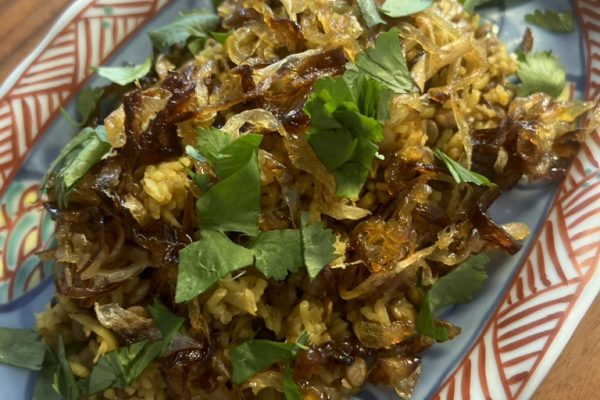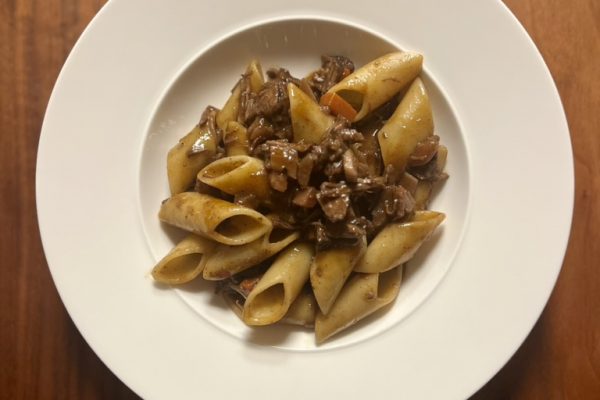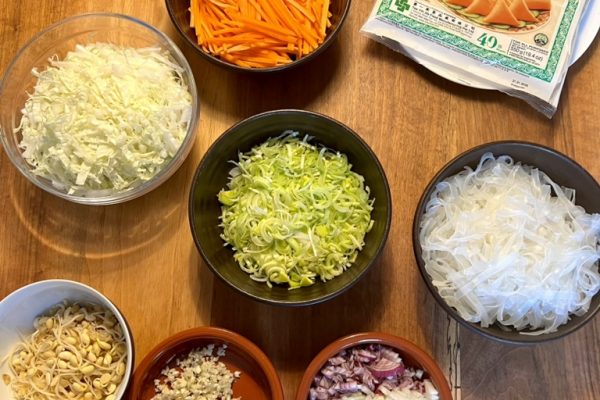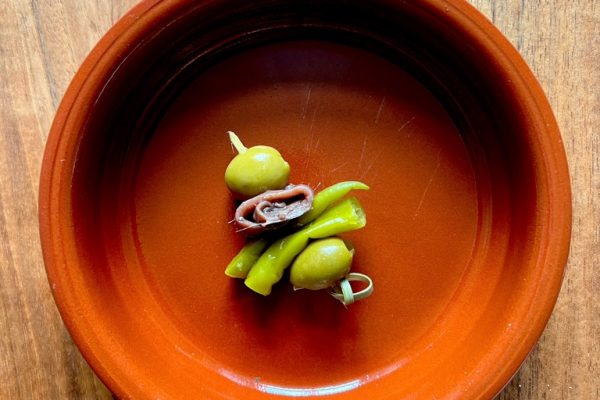Crispy Indian samosa are not so difficult to make yourself, but taste extremely delicious and refined. In India and Pakistan, leftovers are often used for the filling of these delicious dumplings, e.g. vegetable curries. You can get creative yourself and use well-seasoned leftovers from Indian dishes, vegetarian or vegan depending on your taste. Also variants with fish or minced meat are possible. Note that the filling must not be too wet, so that the samosa does not fall apart. Here we have made a classic version with potatoes, peas and onions for the filling.

We use some waxy or mostly waxy potatoes together with two large onions and a handful of peas. You just can’t get good fresh peas in the winter, so frozen ones are fine. While the potatoes are on, we make a dough.
While the potatoes are cooking in salted water for approx. 15 – 20 minutes, we prepare a dough. For this you only need a few ingredients: Regular wheat flour, some salt, water and ghee. Ghee is Indian clarified butter and tastes especially delicious. You can also use vegetable oil instead. The samosa will be even more authentic if you add some whole cumin seeds to the dough.

The ghee must be heated in a pot and made liquid. If you are using oil, this step is not necessary. Be careful not to let the ghee get too hot or let it cool down a bit before making the dough.
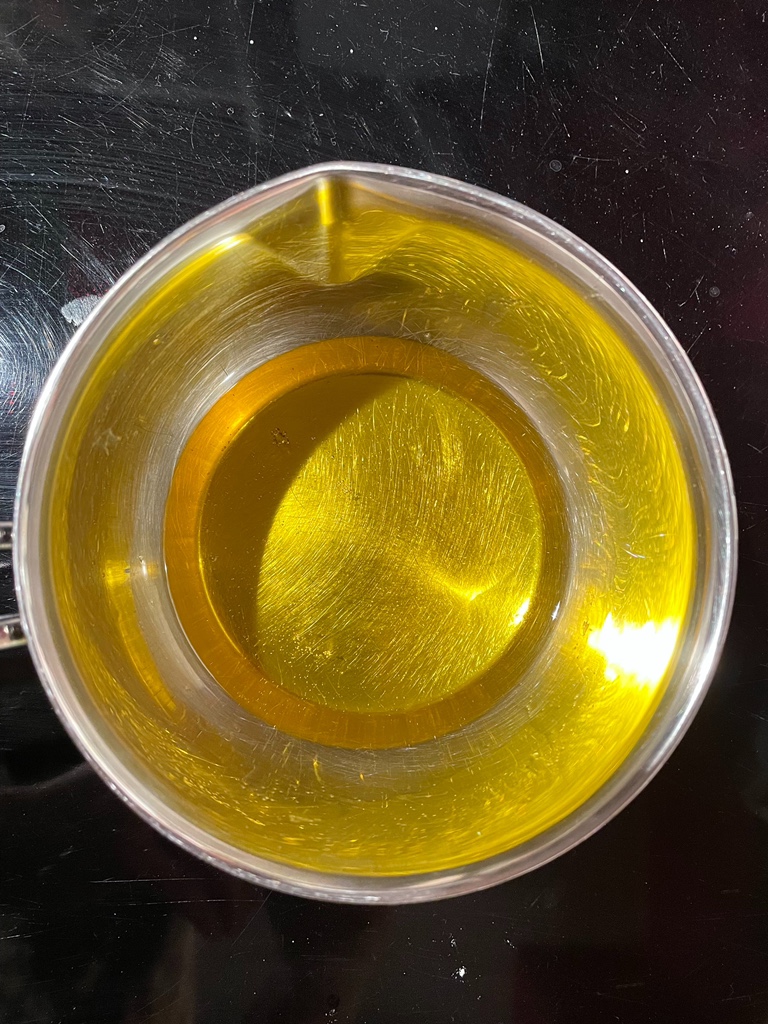
Take a bowl and first mix flour and two to three pinches of salt, then add the liquid ghee.

With your fingertips you can now incorporate the ghee so that small crumbs are formed. When everything is well mixed, slowly add a little water as you continue to knead. The dough is ready when you have a well kneaded homogeneous ball.

While the dough rests, we prepare the filling. Peel the cooked potatoes and cut them into small pieces. Halve the onions and then cut them into cubes or strips that are not too fine. Test the green chili pepper with the tip of your tongue and then use it either with seeds (hotter) or without seeds (less hot), depending on the level of spiciness you want. Chilies without seeds have the least heat if you also wash them out well on the inside. Garlic and ginger you cut into very fine pieces. The best way to peel ginger is shown in this recipe.

If you also want to add a fresh, green chilli in typical Indian fashion, cut off its tip and carefully test its heat level with your tongue. Then use it either with its seeds (hotter) or without (less hot), depending on how spicy you want your dish to be. Chillies have the least heat without seeds and if you wash them well inside.
Now heat a pan with some ghee. First roast the cumin seeds until they are fragrant and then add the ginger, garlic and if you like – the chopped green chili.

Then add the onions to the pan. Toss over the turmeric and garam masala and brown the onions.

Then add the potatoes and peas to the pan and sauté them. Now it’s time for the final seasoning. If you don’t add fresh chilli, you can use hot Madras curry or Kashmiri chili to taste. An important ingredient in a samosa filling is acidity. Squeeze the juice of half a lemon and pour it over the finished filling.

A teaspoonful of nigella seeds is an exciting addition. The spice tastes of spicy black sesame seeds and is quite delicious. In the Islamic world, a saying goes that “nigella cures all diseases except death”. Unfortunately, objective studies have not proven this. Never mind: it’s delicious anyway. At the very end, mix in the chopped cilantro.

The dough has rested enough and can now be filled. To make 12 samosa of the same size, it is best to make two rolls of dough, each of which you divide into 3 pieces. You now have six balls of approximately the same size without having to weigh them.

Roll out the 6 balls with a rolling pin. Do not use too much flour, otherwise the dough will be too dry. If you don’t have a rolling pin, you can also use an empty wine bottle.

Cut each approximately round piece of dough into two halves.

Now it is time for the filling. Form the half circles into a kind of ice cream cone whose tip is the centre of the straight cut edge. As if you were folding a quarter circle, but only press one half of the cut edge onto its other half. If it doesn’t stick well enough, dab a little water on the dough.

You can fit an amazing amount of the filling into each cone.

Now use the overlapping dough as a lid and close the samosa with it.

IIf you now turn the samosa upside down onto this lid, you will see the classic triangular shape. You can now also shape the samosa a little further, if need should be.

We like to fry in a wok using vegetable fat. We use vegetable fat that solidifies again after cooling, because this way we can store and reuse it again much easier. Neutral vegetable oil can of course also be used, but its disposal is more difficult. Larger quantities of vegetable oil should never be put into household waste and certainly not down the drain.

Heat the fat until it is hot, but do not let it rise to the point of smoking. It is hot enough when small bubbles form on a submerged wooden spoon. Carefully put one samosa at a time into the fat and turn them over and over. Don’t worry, they don’t take very long to finish. Do not overcrowd your Wok as this would cool down the oil. The hotter it stays, the crispier the samosa will be.

The best way to remove the finished samosa is to use tongs or a skimmer and immediately pat them dry well with some kitchen paper. This is an important step, because how greasy deep-fried food becomes is decided when it dries. They do not absorb much fat in the hot pan, but only when they cool down after frying.

Samosa taste best with a dip, you can use an Indian sweet and spicy relish. An Asian sweet chili sauce is also good.

Enjoy.
And may the taste be with you.
Ingredients (for 12 samosa – serves 6 as a starter):
For the dough:
250 g wheat flour
4 tsp ghee or the same amount of neutral vegetable oil
2 -3 pinches of salt
½ tsp cumin seeds
150 ml water
For the filling:
600 g waxy potatoes
2 onions
Approx. 50 g peas (frozen)
2 tsp fresh ginger
3 cloves garlic
1 tsp. nigella seeds (optional)
1 tsp curcuma powder (Haldi)
1 tsp Garam masala
Green chili, hot Madras curry or Kashmiri chili (optional)
Juice of half a lemon
Some freshly chopped coriander leaves

